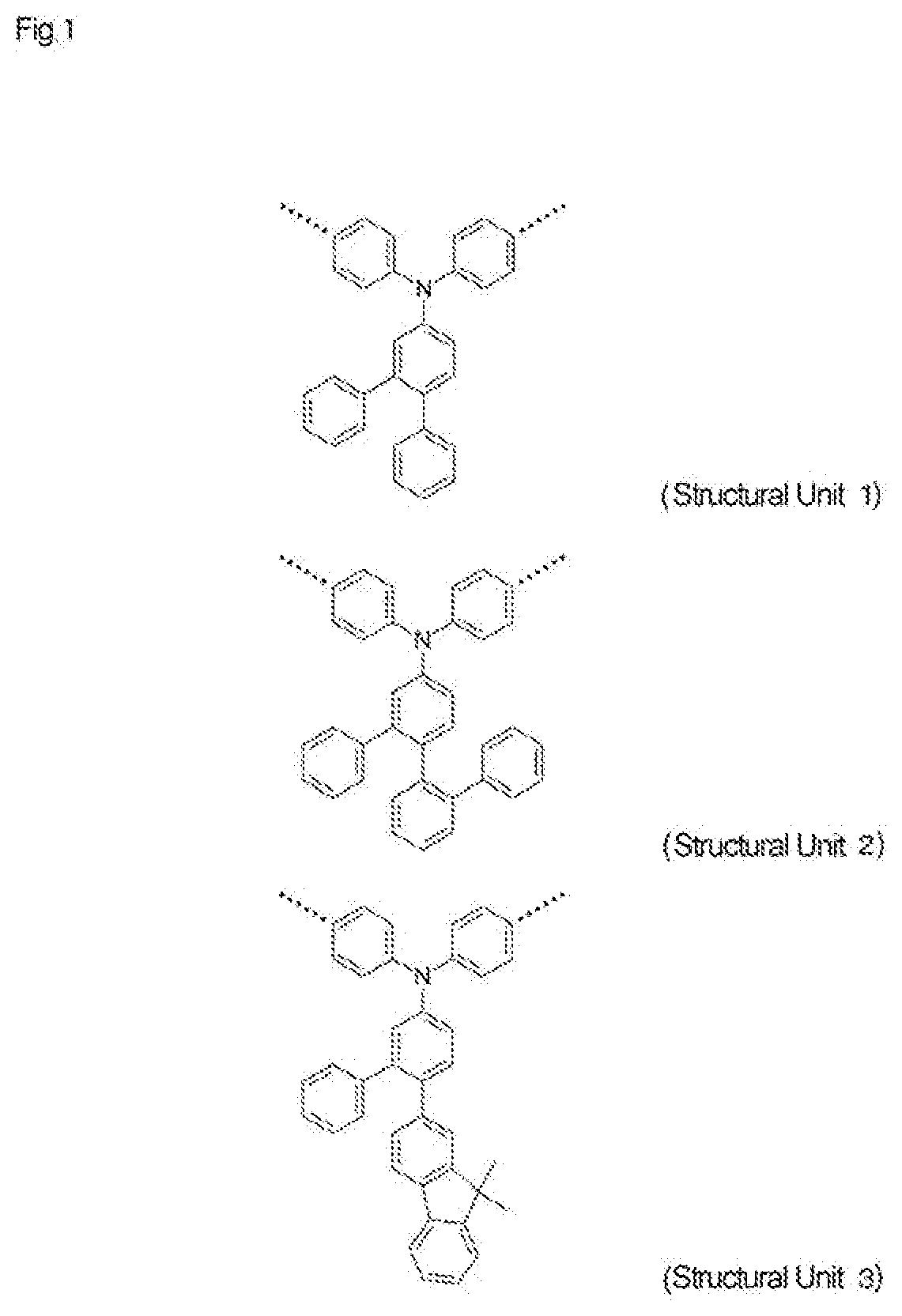High-molecular-weight compound having substituted triarylamine skeleton
a triarylamine skeleton and compound technology, applied in the direction of solid-state devices, chemistry apparatus and processes, and light-emitting compositions, can solve the problems of difficult to deposit uniform thin films on large substrates, low material usage efficiency of vacuum deposition methods, and high production costs. , to achieve the effect of good hole injectionability, good thin film stability, and excellent electron blocking ability
- Summary
- Abstract
- Description
- Claims
- Application Information
AI Technical Summary
Benefits of technology
Problems solved by technology
Method used
Image
Examples
example 1
Synthesis of High Molecular Weight Compound A
[0551]The following components were placed in a reaction vessel whose internal air was replaced with nitrogen, and nitrogen gas was passed through the reaction vessel for 30 minutes:
[0552]2.9 g of 2,7-bis(4,4,5,5-tetramethyl-1,3,2-dioxaborolane-2-yl)-9,9-di-n-octylfluorene;
[0553]2.0 g of intermediate 2;
[0554]0.4 g of N,N-bis(4-bromophenyl)-N-(benzocyclobutene-4-yl)-amine;
[0555]4.0 g of tripotassium phosphate;
[0556]9 ml of toluene;
[0557]5 ml of water; and
[0558]27 ml of 1,4-dioxane.
[0559]Then, 3.3 mg of palladium(II) acetate and 26.7 mg of tri-o-tolylphosphine were added, and the mixture was heated and stirred at 86° C. for 6.5 hours.
[0560]Then, 52 mg of 2,7-bis(4,4,5,5-tetramethyl-1,3,2-dioxaborolane-2-yl)-9,9-di-n-octylfluorene was added and the mixture was stirred for 0.5 hours, and then 140 mg of bromobenzene was added and the mixture was stirred for 0.5 hours.
[0561]Then, 80 ml of toluene and 80 ml of 5 wt % aqueous solution of sodium N...
example 2
Synthesis of High Molecular Weight Compound B
[0570]The following components were placed in a reaction vessel whose internal air was replaced with nitrogen, and nitrogen gas was passed through the reaction vessel for 30 minutes:
[0571]3.6 g of 2,7-bis(4,4,5,5-tetramethyl-1,3,2-dioxaborolane-2-yl)-9,9-di-n-octylfluorene;
[0572]2.8 g of intermediate 6;
[0573]0.5 g of N,N-bis(4-bromophenyl)-N-(benzocyclobutene-4-yl)-amine;
[0574]5.0 g of tripotassium phosphate;
[0575]13 ml of toluene;
[0576]7 ml of water; and
[0577]39 ml of 1,4-dioxane.
[0578]Then, 2.0 mg of palladium(II) acetate and 16.7 mg of tri-o-tolylphosphine were added, and the mixture was heated and stirred at 85° C. for 6 hours.
[0579]Then, 65 mg of 2,7-bis(4,4,5,5-tetramethyl-1,3,2-dioxaborolane-2-yl)-9,9-di-n-octylfluorene was added and the mixture was stirred for 1 hour, and then 180 mg of bromobenzene was added and the mixture was stirred for 1 hour.
[0580]Then, 100 ml of toluene and 100 ml of 5 wt % aqueous solution of sodium N,N-di...
example 3
Synthesis of High Molecular Weight Compound C
[0589]The following components were placed in a reaction vessel whose internal air was replaced with nitrogen, and nitrogen gas was passed through the reaction vessel for 30 minutes:
[0590]6.5 g of 2,7-bis(4,4,5,5-tetramethyl-1,3,2-dioxaborolane-2-yl)-9,9-di-n-octylfluorene;
[0591]5.5 g of intermediate 10;
[0592]0.87 g of N,N-bis(4-bromophenyl)-N-(benzocyclobutene-4-yl)-amine;
[0593]9.0 g of tripotassium phosphate;
[0594]16 ml of toluene;
[0595]9 ml of water; and
[0596]48 ml of 1,4-dioxane.
[0597]Then, 1.9 mg of palladium(II) acetate and 15.0 mg of tri-o-tolylphosphine were added, and the mixture was heated and stirred at 88° C. for 10 hours.
[0598]Then, 22 mg of phenylboronic acid was added and the mixture was stirred for 1 hour, and then 0.32 g of bromobenzene was added and the mixture was stirred for 1 hour.
[0599]Then, 100 ml of toluene and 100 ml of 5 wt % aqueous solution of sodium N,N-diethyldithiocarbamate were added, and the mixture was he...
PUM
| Property | Measurement | Unit |
|---|---|---|
| wt % | aaaaa | aaaaa |
| thickness | aaaaa | aaaaa |
| thickness | aaaaa | aaaaa |
Abstract
Description
Claims
Application Information
 Login to View More
Login to View More - R&D
- Intellectual Property
- Life Sciences
- Materials
- Tech Scout
- Unparalleled Data Quality
- Higher Quality Content
- 60% Fewer Hallucinations
Browse by: Latest US Patents, China's latest patents, Technical Efficacy Thesaurus, Application Domain, Technology Topic, Popular Technical Reports.
© 2025 PatSnap. All rights reserved.Legal|Privacy policy|Modern Slavery Act Transparency Statement|Sitemap|About US| Contact US: help@patsnap.com



